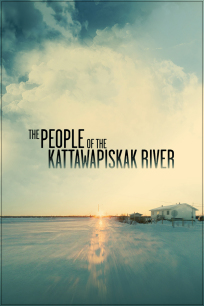Change the conversation, support rabble.ca today.
What lingers from watching Alanis Obomsawin’s new documentary on Attawapiskat’s housing crisis, The People of the Kattawapiskak River, is the contrast. The buildings associated with the De Beers diamond mine close to the native community were all big, robust and in mint condition, the people around them heartily dressed against the cold. In Attawapiskat, just 90 kilometres away, 1,000 of the 1,700 Cree who have lived on this land since before time began to be clocked were housed in scruffy, poorly insulated bungalows with broken siding inside and out, some 25 of them in sheds or teepees. Ninety were living in a cast-off metal trailer donated by De Beers who’d stopped using it for their fly-in temporary workers. Most of the people living in these crisis-condition homes were dressed in jeans, sneakers, hoodies and flimsy nylon jackets.
The contrast speaks to the terrible inadequacy of the Impact Benefit Agreement (IBA) that De Beers, a multi-national mining company with a staff of smart lawyers, has negotiated with local communities like Attawapiskat. According to an article published by MiningWatch Canada based on De Beers’ 2010 annual report, a mere one per cent of the value of diamonds the company extracted in Canada that year ($446 million) went to the eight communities with which it had negotiated these IBAs.
It also highlights what’s so terribly wrong in how ‘development’ is understood. It’s far too narrow in its focus. Instead of considering the broad habitat of places like the territory covered by Treaty 9 in that part of Northern Ontario, it sees and recognizes only resources to be extracted. Instead of considering the long-term life-development goals of a community with its own language and traditional understanding of concepts like ‘development,’ the focus is on jobs in industries like mining.
As Clayton Thomas Mueller, a Cree with the Indigenous Environmental Network, told the Idle No More rally on Parliament Hill January 28, this movement isn’t about “getting a bigger piece of the pie” of market economic development. It’s not about getting more jobs, but about participation, and the right to negotiate what is meant by development, what is meant by jobs. It doesn’t just mean resource extraction, but resource conservation and extraction in ways that honour relations with other inhabitants of the land where the resource is found.
The people of Attawapiskat I met on Victoria Island while Chief Theresa Spence continued her hunger strike there from December 11 through to almost the end of January, people like Danny Metatawabin, weren’t waiting for the Red Cross to help the community solve its housing crisis. They had seized the initiative. They’ve seized the dropped threads of an increasingly toxic development story and are finding the voice to write that story differently, based on the spirits, stories and traditions of their ancestors.
A generation or more of capacity building has brought the Idle no More movement to life. Phase II of this capacity building has now begun. It includes reflecting on and then renegotiating what ‘development’ means, not just for a privileged, powerful corporate few, but for all, and with all including our relations in the bush, in the water and in the sky.
As a fourth-generation settler immigrant to Canada with roots in common and tribal lands in Scotland and a heritage swept aside by the Highland Clearances, I hope to contribute to that renegotiation, drawing on what I’ve learned that remains of the wisdom of my ancestors.
Heather Menzies is completing her tenth book, To the Shieling: A Memoir on Reconnecting with the Earth, which she hopes has something to contribute to the Idle No More conversation.




